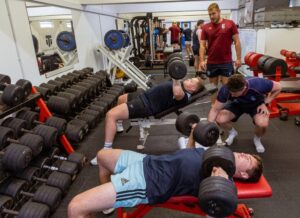Macronutrients for rugby players are an essential component of their diet. And despite some fad diets demonising some of them at different times, all three are essential! In this article we take a look at all three macronutrients; Proteins, Carbohydrates and Fats.

Proteins
Proteins are important and one of the most desired macronutrients for rugby! Players obsess over how much they should be eating. They found in a large number of foods and perform many vital roles in the body. One of the main roles is to supply nitrogen in the form of amino acids, which are the building blocks for protein synthesis, which will lead to muscle growth when combined with resistance training.
The word protein comes from the Greek language and means of primary importance.
- Over 50 % of the dry weight of the human body is protein.
- Protein is the only nutrient that can be used to build muscle.
- The structure of your genes and your brain cells is pure protein.
- All bodily functions, from the blink of an eye to the creation of new muscle tissue, are controlled by thousands of different enzymes. Enzymes are made of proteins.
- Hormones are complex structures of various proteins.
The ‘working parts’ of your structure are constantly being replaced with new proteins. In six months from now your biceps, your blood, your enzymes and even the structure of your genes will all be replaced.
Once protein foods are digested they are broken down into smaller units called amino acids.
There are about 20 different naturally occurring amino acids, of which 9 are essential. This means our bodies cannot make them and therefore they must be supplied in regular and adequate amounts from our foods.
In order for the body to use effectively and synthesise protein all the essential amino acids must be present in the correct proportions. Even the temporary absence of a single amino acid can adversely affect protein synthesis. Therefore meals should contain sources of complete proteins or a balance of incomplete proteins. Food can be grouped into complete and incomplete proteins.
Complete proteins contain all the nine essential amino acids. Examples include meat, poultry, seafood (fish), eggs, milk and most dairy products. Incomplete proteins are foods, which are lacking in certain essential amino acids and cannot be used effectively when eaten alone. Vegetables, seeds, nuts, rice, pasta, grains and beans are good examples.
However by mixing certain incomplete protein foods you can achieve the balance of essential amino acids your body requires, e.g. beans on toast.
How much Protein Should you be eating?
We advise our players to eat between 1.8-2 grams of protein per Kg of bodyweight from good and varied sources
Carbohydrates
The second of the macronutrients for rugby we will look at are the carbohydrates. Carbohydrate sources which are natural are the preferred choice, i.e. if it grows as nature intended then this will be superior to man made, obvious examples include potatoes, fruit, rice, salad and vegetables.
However within this group of natural carbs we can make choices that improve our nutrient intake or provide a slower release of energy, for example a sweet potato provides the same amount of carbs and energy as a baked potato, but the energy will be released at a slower rate and the sweet potato also provides a great source of Beta Carotene, the natural plant form of Vitamin A, which is beneficial for the immune system. Other good examples include choosing whole grain and wild rice over plain quick cook rice, the quick cook rice is highly processed and has less nutrients while the whole grain and wild rice provide more fibre and vitamins.
How much Carbohydrate do you need?
As carbohydrates supply us with our readily available fuel, the amount we need varies with the amount of work we do.
We use a simple traffic light system:
Green (low demand day): Less than 3g per Kg of Bodyweight
Amber (moderate demand day): 3-5g per Kg of Bodyweight
Red (high demand day): Over 5g per Kg of Bodyweight
Fruits & Vegetables
Due to their nutritional and health benefits, it’s recommended that fruit and vegetables form the basis of your diet, with a minimum intake of five portions each day – about a third of your daily food consumption. Currently the UK averages two to three portions a day, so we’re falling well short of the benefits they can provide.
Fruit and vegetables should be incorporated into every meal, as well as being the first choice for a snack. Population studies have shown that people who eat a lot of fruit and vegetables may have a lower risk of chronic disease, such as heart disease and some cancers. Health benefits can be gained from fresh, canned (in natural juice), frozen, cooked, juiced or dried versions. Potatoes don’t count though, as they’re a starchy food.
Fruit and vegetables of differing colours contain diverse mixtures of phytonutrients (protective plant compounds). These can act as powerful antioxidants, protecting the body from harmful free radicals and helping to protect against certain chronic diseases such as cancer. Some fruit and vegetables are labelled as ‘superfoods’ because they contain high concentrations of some phytonutrients, particularly antioxidants, which appear to be beneficial to health.
Blueberries – contain flavonoids that can improve circulation and help defend against infection
Broccoli – rich in the antioxidants vitamin C and beta-carotene, as well as folate, all of which can protect against cardiovascular disease and cancer
Tomatoes – rich in lycopene, a powerful antioxidant that can protect against harmful free radicals.
But variety is the key. In addition to these phytonutrients, each variety of fruit and vegetables contains its own combination of vitamins, minerals and fibre. Choosing a variety throughout the day will provide a diverse package of essential nutrients.
Fats
The third and final, albeit no less important macronutrients for rugby in this article, are the Fats. Athletes need good fats in their diet. Fat is the most energy dense of all the macronutrients, containing 9 calories per gram. (Carbohydrates and proteins contain only 4 calories per gram).
Unsaturated fats have empty spaces where hydrogen atoms are missing. These spaces link up with molecules making them biologically active. These good fats have certain roles to play such as –
- Forming the major components of cell membranes
- Play a major role in the brain, eyes and ears
- Needed for the adrenal glands and the production of hormones
Mono-unsaturated fats are considered to have a beneficial effect on the heart by improving cholesterol ratios. This is achieved by lowering LDL (the bad cholesterol) while not affecting the (good cholesterol) HDL.
This type of fat is found in olive, rapeseed and peanut oils.
Poly-unsaturated fats contain the essential fatty acids. These fatty acids are a sub group that our bodies cannot manufacture and therefore need to be consumed in regular and sufficient amounts.
The two essential fatty acids are Omega-3 and Omega-6.
Saturated Fats
There is evidence on high saturated fat intake being implicated with heart disease, however it is not fully known if those studied were also eating foods rich in trans fatty acids. Saturated fats found in highly processed foods should be avoided.
For young athletes we should not be concerned with moderate levels of saturated fats found in natural wholesome foods such as eggs, red meats and whole milk. These are all nutritious foods that provide protein and vitamins and useful calories.
There has been good research to show a moderate saturated fat intake will maintain better testosterone levels than a low fat diet
Omega 3’s
Omega-3 fats are protective against factors, which can lead to heart disease. Studies have shown Omega-3 to:
- Reduce the build up of fat in blood vessels
- Prevent blood clots forming by regulating the viscosity of the blood
- Reduce triglyceride levels
- Lower blood pressure
- Increase the flexibility of arterial walls allowing for improved blood flow
- Omega-3 and athletic performance
Current research shows boosting omega-3 intakes may:
- Enhance oxygen delivery
- Increase energy levels
- Reduced inflammation caused by intense training
- Improved insulin sensitivity
- Reduce Bodyfat
- Maintain lean muscle during injury phases
Rich Sources of Omeg-3 Fatty Acids
Oily fish – salmon, fresh tuna, herring, mackerel, kippers, sardines, pilchards, flaxseeds, nuts, vegetable oils including flaxseed, rapeseed, and walnut oil, eggs. Free range eggs have higher levels of omega 3 than eggs from caged eggs.
Omega 6’s
Omega 6 fatty acids cannot be manufactured in the body however current western eating patterns show we are already consuming sufficient Omega 6. The focus should be on increasing the intake of Omega-3 to balance essential fatty acid ratios. Sources include vegetable oils such as sunflower, maize, cottonseed, peanut and grapeseed, and margarines
Fats to Avoid – Trans Fatty Acids
Modern processing changes the chemical character of fatty acids in oils which results in the human body being unable to use them. A trans fat is created when hydrogen is added to vegetable oil to keep it stable for frying and prevent it from going rancid. These trans fatty acids behave like saturated fats and lower good cholesterol (HDL) and increase bad cholesterol (LDL).
Found in highly processed foods such as cakes, chocolates, frozen meals, pies, processed meats and oils such as palm and kernel oils. These fats are potentially the most harmful and there is serious concern regarding their implications for cardiovascular health.
Avoid trans fatty acids where possible.
How much Fat do you need?
Providing that you get your Fat from good sources at it is made up of high quality “healthy” fats, we advise 1g per Kg of Bodyweight
Macronutrients for Rugby: Summary
In this article we have presented you with plenty of information about how to get your macronutrients for rugby in balance and of high enough quality to maximise your nutrition. If you are looking for more information to fine tune your diet, click the button below.




